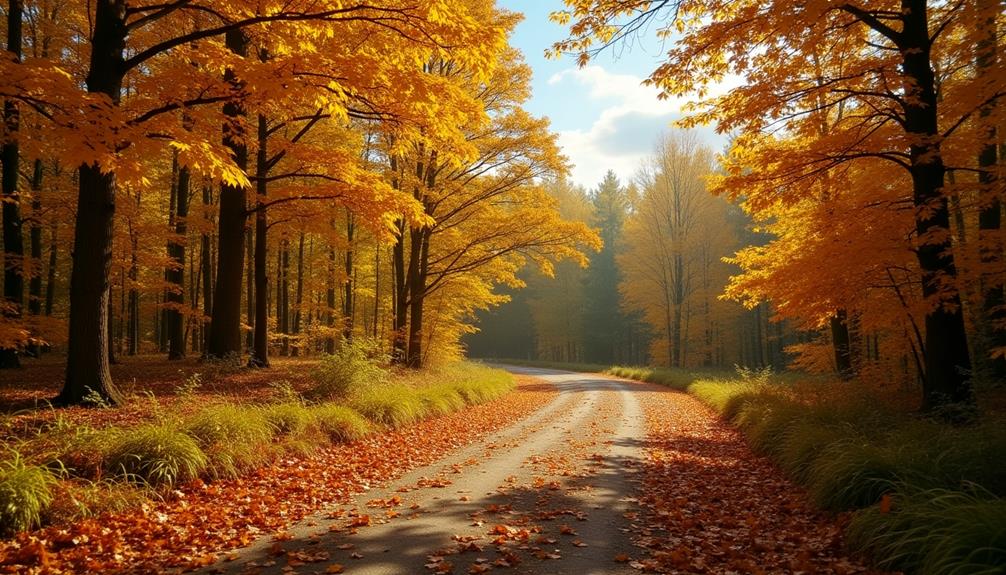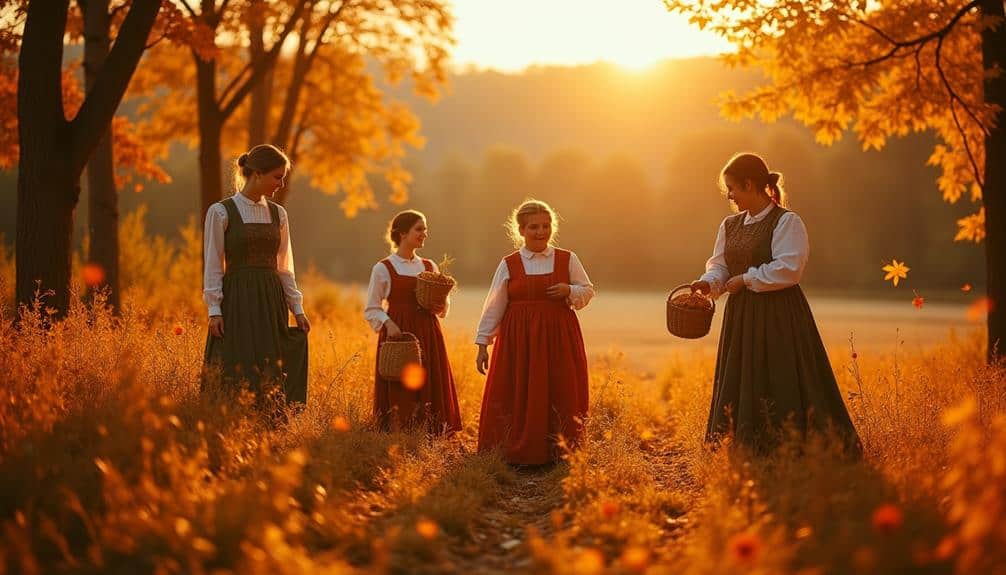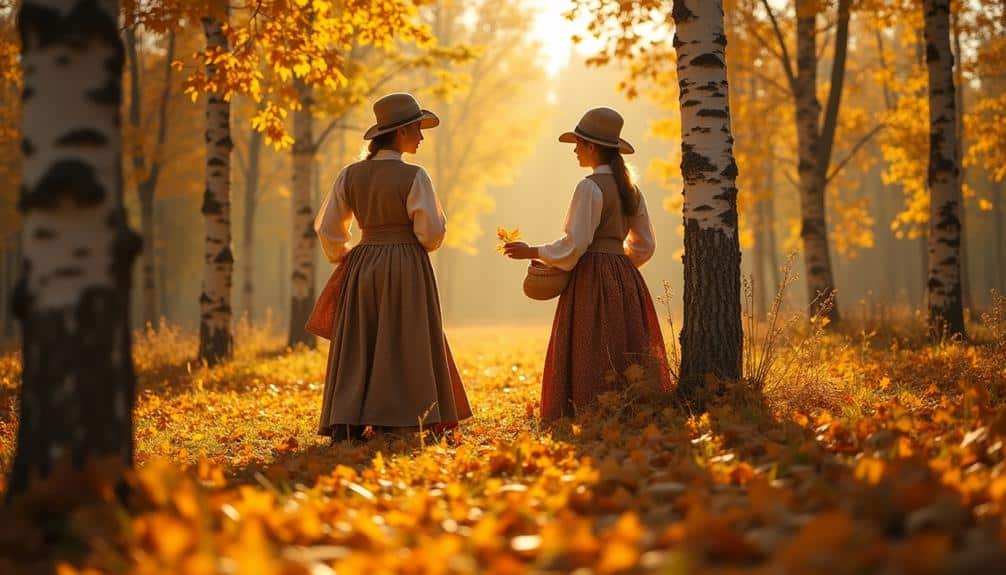Russia’s early fall season, affectionately termed “Women’s Summer” or бабье лето, emerges as a fleeting yet profound moment in the cultural and natural landscape of the country. This period in September, marked by a temporary return of warmth, serves as both a celebratory close to the harvest and a tribute to women’s indispensable roles in rural communities. The season’s ephemeral nature invites reflection and nostalgia, as vibrant autumnal hues intertwine with outdoor festivities.
Introduction

The phenomenon known as бабье лето, or “women’s summer,” serves as a cultural and meteorological bridge in Russia, marking a brief period of warmth and sunshine that contrasts with the approaching winter.
As September unfolds in Russia, a unique climatic change known as бабье лето marks the landscape with an unexpected warmth that contrasts against the backdrop of approaching winter. This period, often referred to as “women’s summer,” is characterized by stable weather patterns that temporarily halt the seasonal changes descending into harsher climates.
Historically, бабье лето holds significant cultural and agricultural importance, serving as a brief reprieve for communities to prepare for winter. The term itself evokes images of women working tirelessly in the fields, as this time allowed for the completion of essential agricultural tasks.
It highlights women’s roles in rural societies, emphasizing their contribution to the harvest and household preparations. Cultural rituals during this time often revolve around gratitude for the bountiful yield and anticipation of colder months.
In essence, бабье лето is not merely a meteorological phenomenon but a cultural legacy that underscores resilience and adaptability. It celebrates a fleeting freedom from the impending chill, inviting a momentary embrace of warmth and reflection.
Consequently, it continues to be a cherished interlude, deeply woven into the fabric of Russian cultural consciousness.
The Origins of “Women’s Summer”
In Russian cultural tradition, “women’s summer” holds a historical resonance that dates back several centuries, intertwining folklore and agrarian life. This period, occurring in early autumn, is not merely a meteorological phenomenon but a tapestry woven with historical celebrations and the rhythms of agricultural practices.
As the harvest concludes, the land yields its bounty, prompting communities to engage in festive activities that celebrate the cycle of life and labor. This fleeting warmth, echoing the importance of summer, is captured in folklore tales that speak to the enduring spirit of women, who have long been central to rural life.
The concept of “women’s summer” in Russia is deeply rooted in the interplay between the earth’s cyclical nature and societal roles. Women’s contributions to agrarian societies were crucial, especially during this seasonal shift.
As the days grew shorter, women were celebrated for their resilience and integral roles in managing both household and harvest. These historical celebrations embraced the essence of seasonal changes, embodying a collective acknowledgment of women’s roles not only in sustaining families but also in sustaining the cultural heritage of their communities.
Consequently, “women’s summer” emerges as a symbol of continuity and renewal, reflecting a harmonious balance between humanity and nature.
Connection to traditional roles of women in rural communities post-harvest
During the early autumn period known as “women’s summer” in Russia, the traditional roles of women in rural communities come into sharp focus, particularly following the harvest. This time of year highlights the culmination of agricultural practices, where the fruits of labor are celebrated, and the community bonds are strengthened.
The rural traditions deeply ingrained in these societies often placed women at the heart of post-harvest activities, integral to the seasonal rituals that define this period. Historically, women’s roles extended beyond mere participation; they were essential in ensuring the continuity and success of community life.
After the harvest, women engaged in activities that fostered community cohesion, such as organizing feasts and gatherings that underscored the collective achievements. These events were not just social occasions but also opportunities for reinforcing cultural values and traditions.
In rural settings, the seasonal rituals of “women’s summer” served as a reminder of women’s contributions to both the family and the broader community. Their work was pivotal in maintaining the social fabric, ensuring that the community thrived through the shift from harvest abundance to the introspective winter months.
Such roles allowed women to exercise agency, fostering a sense of autonomy and unity within these traditional societies.
Description of lighter tasks performed by women during this period
As the harvest season drew to a close, a shift in the rhythm of rural life marked the onset of “women’s summer” in Russia, characterized by a change in the responsibilities undertaken by women. During this period, the demanding agricultural tasks that had dominated the summer months gave way to more serene activities.
Women engaged in light gardening tasks, tending to the remaining herbs and late-blooming flowers, ensuring the land’s readiness for the coming winter. This alteration allowed for a moment of respite, a brief pause in the agricultural calendar that celebrated the earth’s bounty.
Women’s summer also provided an opportunity for folk art projects, where women expressed their creativity through embroidery, weaving, and other crafts. These artistic endeavors were often communal, bringing women together to share techniques and stories, strengthening social bonds in the process.
In parallel, communal cooking became a focal point of daily life, as women prepared for the harvest celebrations, crafting meals that highlighted the season’s produce.
Nature walks were another cherished activity, offering a chance to connect with the changing landscape, reflecting on the cycle of life. This period symbolized both a culmination and a promise of renewal, embodying a cultural rhythm deeply rooted in freedom and tradition.
Superstitions regarding women’s influence over weather patterns
Russia’s folklore is rich with superstitions that weave women’s roles into the tapestry of nature, particularly during the early fall season known as “women’s summer.” This period, steeped in cultural heritage, is often attributed to the mystical influence women are believed to have over weather patterns.
In the domain of weather folklore, this phenomenon is revered as a time when women’s innate connection to nature manifests in warmer, clearer days that seem to defy the approaching chill of winter.
Historically, “women’s summer” is tied to seasonal rituals and agricultural beliefs that underscore the feminine symbolism in nature’s cycles. Women were seen as custodians of the earth’s fertility, their presence believed to invoke favorable weather for harvesting.
Their activities during this time were often light and celebratory, reflecting a harmonious relationship with the environment.
In cultural interpretation, “women’s summer” symbolizes a brief respite, a fleeting freedom from the constraints of the brutal Russian winter. The belief in women’s influence over weather patterns speaks to a deeper understanding of their essential role in sustaining life and prosperity.
Consequently, this period not only celebrates the season but also venerates women’s enduring connection to nature.
Cultural Significance
Astronomical observations have long linked the appearance of the Pleiades in the night sky with the changing seasons. For ancient communities, the constellation served as a guide for celestial navigation, indicating the impending shift from summer to autumn.
This period, characterized by the last days of warmth, was celebrated in cultural folklore as a time to harvest the remaining crops and prepare for winter, echoing the nurturing qualities attributed to women.
The cultural folklore surrounding the Pleiades underscores the constellation’s enduring impact on human life, reflecting a deep connection between celestial patterns and earthly existence.
The Pleiades’ presence in the night sky therefore enhances the cultural interpretation of “women’s summer,” highlighting the intertwining of mythology, astronomical phenomena, and seasonal cycles in shaping human traditions.
Celebrating Women’s Summer

The celebration of “Women’s Summer” in Russia is deeply rooted in cultural traditions that emphasize communal joy and preparation for the harsh months ahead.
Historically, this period has been marked by outdoor activities such as festive picnics, sunlit boat tours, and communal singing, which serve not only as leisure but also as a symbolic farewell to summer’s warmth.
These gatherings provide an opportunity for communities to engage in sunbathing and other activities, while also focusing on preparing preserves and resources essential for the winter season.
Traditional Festivities
Women’s Summer in Russia is marked by a vibrant tapestry of traditional festivities and community gatherings that serve as a cultural touchstone, celebrating the shifting beauty of early autumn. Historically, this period has been characterized by a profound sense of community spirit, as villages and towns come alive with a series of events that honor the bountiful harvest and the ending of the agricultural cycle.
Harvest celebrations, deeply rooted in local traditions, often include fairs and markets where seasonal foods take center stage, showcasing the richness of the land’s produce.
Family gatherings are an integral aspect of these celebrations, offering an opportunity for relatives to reconnect and reflect on the year gone by. Such gatherings often involve communal feasts where traditional dishes made from freshly harvested ingredients are shared, reinforcing familial bonds and community ties.
Celebrating “women’s summer” in Russia is deeply embedded in a rich tapestry of outdoor activities that blend cultural heritage with seasonal appreciation. This period, characterized by fleeting warmth and golden light, invites individuals to explore the diverse hiking trails that crisscross the Russian landscape.
These trails offer not just a physical journey, but an exploration of Russia’s storied past and its natural beauty. Outdoor photography becomes a cherished endeavor, capturing the fleeting hues of the season and preserving moments of tranquility and reflection.
The vibrant colors of the foliage set against clear blue skies provide a perfect backdrop for photographers seeking to encapsulate the essence of “women’s summer.” Nature walks during this time foster a deeper connection with the environment, as participants experience the subtle changes that signal the shift from summer to fall.
As night falls, stargazing nights offer a celestial escape, inviting contemplation under the vast Russian sky. Harvest festivals, rooted in ancient traditions, celebrate the bounty of the earth and the community’s resilience.
These gatherings reflect a collective spirit of gratitude and freedom, offering a ceremonial pause before the inevitable arrival of winter, and embodying a harmonious blend of nature and culture.
Popular Activities
How does one truly capture the essence of Russia’s “women’s summer”? This fleeting period invites an exploration of leisure activities that celebrate the gentle warmth and rich colors of early fall.
Traditionally, Russians have embraced this time by gathering at scenic picnic spots, such as the verdant parks and serene countryside, where families and friends savor the last of the year’s outdoor feasts. These gatherings, rooted in communal traditions, offer a sense of liberation from the encroaching winter chill.
The waterways of Russia also come alive during this season. Boat rentals provide the perfect opportunity for leisurely excursions, allowing individuals to bask in the sun’s lingering rays while gliding past the picturesque autumnal landscape. Such experiences echo the historical love affair Russians have with their rivers, fostering a deep connection with nature.
Autumn hikes through the colorful, sprawling forests offer another layer of freedom, inviting adventurers to immerse themselves in the rustling leaves and crisp air.
Meanwhile, local markets thrive, brimming with seasonal produce and artisan crafts, capturing the rustic charm and vibrancy of “women’s summer.” Outdoor concerts, too, enhance this cultural tapestry, as music fills the air, harmonizing with the season’s gentle embrace.
Urban experiences in cities like Moscow and St. Petersburg
While the allure of Russia’s countryside during “women’s summer” is undeniable, the urban landscapes of cities like Moscow and St. Petersburg offer a vibrant tapestry of experiences. As the warmth of this fleeting season graces the cities, urban parks become lively sanctuaries.
Gorky Park in Moscow and the Summer Garden in St. Petersburg transform into hubs of leisure and artistic expression. Here, cultural festivals celebrating Russian heritage and contemporary art thrive, offering residents and visitors a rich palette of experiences.
Street performances abound, with musicians and dancers infusing the air with an infectious energy that defies the impending chill of winter. These urban experiences are complemented by the savoring of local cuisine at outdoor cafes, where traditional dishes like borscht and pelmeni meet innovative culinary creations, enticing the palate with seasonal ingredients.
Moreover, “women’s summer” heralds a shift in seasonal fashion, as the city’s streets become runways for expressive styles that blend the warmth of early autumn with the vibrant textures of Russian culture.
For those seeking freedom in exploration, Moscow and St. Petersburg during this period offer an enchanting intersection of tradition, innovation, and the timeless beauty of urban life.
A Time for Reflection
Amidst the shifting tapestry of seasons, бабье лето, or “women’s summer,” emerges as a poignant interlude in Russia’s climatic calendar. This period, characterized by changing beauty, holds a reflective charm as it marks the bridge between the warmth of summer and the impending chill of winter.
The seasonal changes during this time invite emotional shifts among those who experience it, as they witness the gradual transformation of the landscape. Nature’s changes manifest in the vibrant hues of autumn leaves and the crisp, clear skies, offering a moment for cultural reflections on the cyclical nature of life.
Historically, бабье лето has been a time when rural communities in Russia completed their harvests, utilizing the unexpected warmth to secure provisions for the cold months ahead.
The period of бабье лето not only connects seasons but also embodies the profound symbolism of change as nature readies itself for the starkness of winter. This fleeting interlude marks a seasonal alteration, where the vibrant hues of autumnal beauty begin to emerge, offering a final spectacle before the landscape succumbs to winter’s monochrome.
Historically, this time has invited reflection on nature’s resilience—a proof of its ability to endure and rejuvenate despite impending adversity.
Culturally, бабье лето provides an opportunity for harvest reflections, evoking a sense of gratitude and contemplation. As communities gather the season’s yield, this period serves as a reminder of the cyclical nature of life, echoing themes of preparation and change.
In Russian folklore, this time is imbued with an emotional shift, where warmth and nostalgia interlace with an awareness of the impermanence of seasons.
For those who yearn for freedom, бабье лето represents an invitation to embrace change, acknowledging the beauty in transformation and the promise of renewal.
In the gentle embrace of бабье лето, there exists a poignant opportunity to reflect on the labor of past months and the inexorable passage of time. This shift period in Russia, while deeply rooted in cultural memories, invites contemplation on the interplay between nature’s rhythms and human endeavor.
Historically, бабье лето was a time when women, who played pivotal roles in both domestic and agricultural spheres, could pause and survey their labor’s fruits. The season’s warmth, unexpectedly lingering, offered a brief respite and a chance to move from the demanding summer months to the introspective winter.
Labor reflections during this period are intertwined with the acknowledgment of women’s roles, both celebrated and understated. As seasonal shifts occur, the land itself seems to echo the cyclical nature of toil and rest, mirroring the broader human experience.
This fleeting warmth becomes a metaphor for life’s impermanence, urging one to cherish each moment amidst the relentless march of time. Such reflections resonate with an audience yearning for freedom, offering a narrative where cultural traditions honor individual contributions while acknowledging the unyielding cadence of the seasons.
As the warmth of бабье лето envelops the landscape, a period of emotional resonance emerges, inviting a deeper reflection on the intertwining narratives of nature and human experience.
This fleeting season, imbued with warmth’s significance, offers a unique opportunity for seasonal reflections. It prompts individuals to pause and examine their emotional connections with the world around them.
Historically, бабье лето has served as a bridge between the vibrant days of summer and the impending chill of winter, a time when cultural memories resurface, rich with nostalgia’s impact.
The term “women’s summer” itself evokes imagery of life’s cycles, reminiscent of the wisdom and serenity often associated with elder women. This connotation emphasizes a gentle shift, mirroring the inner transitions individuals experience as they embrace change.
The emotional resonance of this period lies in its ability to evoke a sense of continuity, where the warmth of the sun becomes a metaphor for the enduring nature of human spirit and resilience.
In a society that continually seeks freedom from the mundane, бабье лето becomes a symbolic canvas for introspection, reminding us of the profound connections between our past, present, and future selves.
The Beauty and Cultural Importance of “бабье лето”

The enchanting period known as “women’s summer” holds a unique place in Russian culture, evoking warmth and introspection before the harsh winter months. Emerging as a tranquil pause between the intensity of summer and the impending chill of winter, this season serves as a celebration of summer memories and the essence of seasonal shifts. As leaves begin to change, it invites nostalgic reflections on warmer days, intertwining them with cultural traditions that honor nature’s beauty.
Historically, this period has been an opportunity for communities to pause and appreciate the artistry of nature. The golden hues of the landscape reflect sunlit memories, providing a canvas for contemplation and creativity. As daylight diminishes, it encourages a deeper appreciation for the freedom found in the simplicity of the natural world.
For those unable to experience this enchanting season firsthand, these weeks can still be embraced through memories. Recalling gentle breezes and the sun’s warm embrace fosters a connection to this captivating time. Whether through personal reflection or shared stories, “women’s summer” remains an enduring reminder of our ties to nature and the cultural rhythms that shape our lives.




